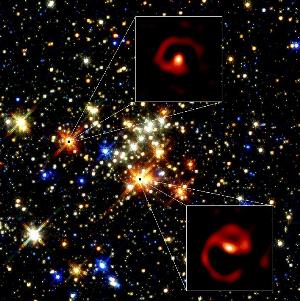21 August 2006
 |
The two stars rotate around one another, spewing out dust in a spiral arc like a lawn sprinkle |
A University of Sydney astrophysicist has discovered a pair of red stars at the centre of our galaxy that look just like giant Yan and Yang symbols.
The stars make up part of the five-star
Quintuplet Cluster - one of the most massive clusters in the Milky Way
Galaxy. These giant stars - between 10 and 20 times the mass of our sun
- live fast and die young, according to astrophysicist
"These massive stars shove everything around with their strong winds, exerting a big influence on the evolution of the galaxy as a whole," said Tuthill, who led the group that published images of the two confirmed pinwheels in the Quintuplet Cluster in the most recent issue of Science.
The
pinwheel shape characteristic of two stars rotating around one another,
and spewing out dust in a spiral arc like a rotating lawn sprinkle, was
captured by the world's biggest telescope - the Keck I telescope on
Mauna Kea in
Called Wolf-Rayet stars, they have strong stellar winds that, in a binary system of two such massive stars, collide and generate copious dust. "Wolf-Rayet stars are very compact and hot, driving off intense stellar winds," he said.
The Quintuplet Cluster is less than 100 light years from the core of the Milky Way Galaxy, located 25,000 light years from Earth. Estimated to be about 4 million years old, the cluster's massive young stars shine brighter than any cluster in the galaxy. Though obscured by dust until 1990, infrared imaging has since revealed the five brightest stars to be 10,000 to 100,000 times brighter then the sun.
Massive stars like those in the Quintuplet Cluster are important because, though they typically make up only a few percent of the stars in a galaxy (a few thousand stars out of the billions that exist) they outshine all the other stars put together. They also exert a strong influence on other stars because of their intense stellar winds.
Binary systems like those in the Quintuplet Cluster are destined for three supernova explosions which send off the heavier elements into spaces that form planets around smaller stars.
The work was supported by the Australian Research Council and the National Science Foundation.
Contact: Kath Kenny
Phone: 02 9351 2261 or 0434 606 100



